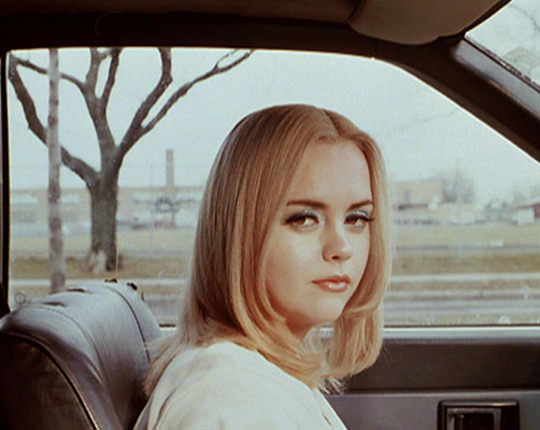
|Ann Romine|
Five minutes into Buffalo ‘66, Billy Brown needs to find a bathroom. To remedy this situation, he decides to return to the prison from which he was just released, a move that immediately characterizes the film’s protagonist as a lost soul.
On a winter day in Buffalo, New York, a misty glow emanates from the overcast sky while high contrast reveals saturated colors. This scene provides the setting for Buffalo ‘66. Shot on reversal 35mm film, the effect in Vincent Gallo’s 1998 movie––both vintage and other-wordly––blurs the line between Billy’s internal struggle and his external reality. Although we can deduce the story takes place during the mid to late 1990s, the film’s sets and costumes obscure the time period in Buffalo ‘66; for example, a 1960s radio and dial phone sit on a motel nightstand, lending a dreamlike atmosphere to this darkly comic melodrama.
The film’s narrative poses a central question: why does Billy Brown bet on the Buffalo Bills to win Super Bowl XXV, knowing the consequences of losing? Resigning himself to the reality of his situation, Billy admits, “I’m fucked. And I’m dead.” The bet is an act of desperation rivalled only by his attempt to reconnect with his emotionally unavailable parents.
His desperation is revealed in a tableau-style dinner scene, where the recently kidnapped Layla (Christina Ricci) shines with sharp wit as Billy’s new “wife,” inventing the tale of Billy’s success in the CIA and the story of how the young couple fell in love. Magically lit in a shimmering blue dress, Layla is a light that illuminates the dark oblivion of Billy’s home. Jan Brown’s (Angelica Huston) hilarious fanaticism for the Buffalo Bills (their home is a virtual shrine) raises the tension of the homecoming scene while Jimmy Brown’s (Ben Gazarra) torch-light-song sung in spotlight adds an element of surrealism.
Almost an exaggeration of bully, Billy’s behavior toward both Layla and his friend Rocky (aka Goon) is cruel and abusive, but not surprising. What really stands out is how they respond to him. Layla observes Billy’s behavior and reacts to his controlling anger, but never with fear or feelings of subjugation. Staying true to herself, Layla seems to function as a mirror for Billy; her character allows the protagonist to see himself and his value.
Resisting Billy’s aggressive demands, Rocky protests when Billy calls him Goon: “I don’t want people to call me that no more, even you,” he asserts, as he refuses to help Billy locate the Bills’ kicker who missed the winning field goal, Scott Wood. “You shouldn’t go down there,” Rocky advises, “don’t go down there. Don’t do bad things.”
In contrast, the bowling alley scene provides slow motion close ups of Billy and Layla as they settle in, creating a meditative feel and depicting a shift in the film’s mood. The feel-good scene shows Billy and Layla performing in turns––Billy, “The King,” bowls strike after strike, and Layla performs an iconic tap dance to the sad sexy song “Moonchild” by King Crimson.
Toward the end of the film, the slow-motion and freeze-frame shots (which precede similar techniques used in The Matrix) at Scott Wood’s strip club build stylized suspense, intensified by the driving sounds of “Heart of the Sunrise” by Yes. Confronted with his ultimate dilemma, Billy’s vision of his potential future is imagined in a Dickensesque way, and he virtually explodes with emotion in the final throes.
In the end, Billy seems to take to heart the message from the billboard towering over the bowling alley parking lot, and it’s hard not to be happy for him.
Buffalo ’66 screens at Trylon on Thursday, November 7 as part of the Volunteer Programmer’s series. The film was programmed by Ann Romine, Trylon volunteer since 2009. Find details and more info about the screening on our website.
